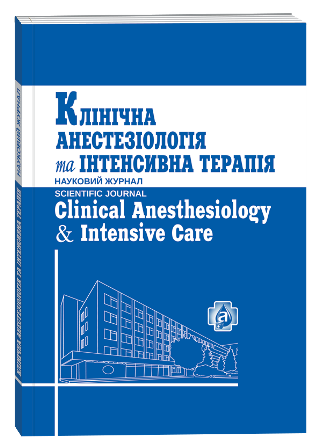ЗЛОКАЧЕСТВЕННАЯ ГИПЕРТЕРМИЯ: МИФ ИЛИ РЕАЛЬНОСТЬ
Ключові слова:
анестезия, злокачественная гипертермия, контрактурный тест, дантроленАнотація
Актуальность. Одним из факторов риска анестезиологической помощи является развитие такого осложнения как злокачественная гипертермия (ЗГ). Этот феномен введен в медицинскую практику с 1960 г. Смертность от ЗГ значительно снизилась с пониманием патофизиологических процессов, происходящих в организме и появлением специфической терапии, но летальные исходы случаются до сих пор при фульминантном течении злокачественной гипертермии. Описание клинического случая. У пациента, которому оказывалась анестезиологическая помощь с пропофолом, изофлюраном и атракурия бессилатом для проведения оперативного вмешательства в объеме аппендэктомии, развилась ЗГ. Пациент умер от развившейся полиорганной недостаточности при отсутствии дантролена. Выводы. Криз ЗГ является редким осложнением с серьезным риском летального исхода для восприимчивых лиц. Для того чтобы сохранить смертность низкой, необходимо проводить подробный предоперационный осмотр и сбор анамнеза, адекватный интраоперационный мониторинг, иметь в наличии достаточный запас дантролена и тщательно подготавливать анестезиологов и коллектив в любом медицинском учреждении, где проводится общая анестезия.
Посилання
Denborough M. Anaesthetic deaths in a family / M. Denborough, R. Lovell // Lancet. – 1960. – N 2. – P. 45.
Emergency Treatment for An Acute MH Event [Electronic resource]. – Access mode : http://www.mhaus.org/healthcare-professionals/managing-a-crisis
Mutations in RYR1 [Electronic resource]. – Access mode : https://emhg.org/genetics/mutations-in-ryr1/
Sudden death due to malignant hyperthermia during general anesthesia / K. Wochna, A. P. Jurczyk, W. Krajewski, J. Berent // Arch Med Sadowej Kryminol. – 2013. – N 63 (1). – P. 11–4; 7–10.
Case report: Death in the emergency department: an unrecognized awake malignant hyperthermia- like reaction in a six-year-old / W. A. Lavezzi, J. F. Capacchione, S. M. Muldoon [et al.] // Anesth Analg. – 2013. – N 116 (2). – P. 420–423.
A fulminant Malignant Hyperthermia Episode in a Patient with ryanodine receptor Gene Mutation p. Tyr522Ser / T. Girard, M. Suhner, S. Levano [et al.] // Anesthesia&Analgesia. – 2008. – N 107 (6). – P. 1953–1955.
A survey for prevention and treatment of malignant hyperthermia in Taiwan / W. H. Yip, C. L. Mingi, S. J. Ooi [et al.] // Acta Anaesthesiol Taiwan. – 2004. – Vol. 42 (3). – P. 147–151.
Trends and outcome of Malignant Hyperthermia on the United States, 2000 to 2005 / E. B. Rosero, A. O. Adesanya, C. H. Timaman [et al.] // Anesthesiology. – 2009. – N 110. – P. 89–94.
Regional distribution of predisposition to maligant hyperthermia in Germany: date in 1997 / E. Hartung, M. Anetseder, D. Olthoff [et al.] // Anasthesiol Intensivmed Notfallmed Schmerzther. – 1998. – N 33 (4). – P. 238.
Malignant hyperthermia in Canada: characteristics of index anesthetics in 129 malignant hyperthermia susceptible probands / S. Riazi, M. G. Larach, C. Hu [et al.] // Anesth Analg. – 2014. – N 118 (2). – P. 381–387.
A protocol for the investigation of malignant hyperpyrexia (MH) susceptibility. The European Malignant Hyperpyrexia Group / British Journal of Anaesthesia. – 1984. – N 56 (11). – P. 1267–1269.
Prediction of malignant hyperthermia susceptibility in low-risk subjects. An epidemiologic investigation of caffeine halothane contracture responses. The North American Malignant Hyperthermia Registry / M. G. Larach, J. R. Landis, J. S. Bunn [et al.] // Anesthesiology. – 1992. – N 76 (1). – P. 16–27.
Criteria for gene mutations to be used in genetic testing of Malignant Hyperthermia susceptibility. – Available at : emhg.org/fileadmin/EMHG/redaktion/Guidelines/Mutationcriteria2003. pdf
A clinical grading scale to predict malignant hyperthermia susceptibility / M. G. Larach, A. R. Localio, G. C. Allen [et al.] // Anesthesiology. – 1994. – N 80 (4). – P. 771–779.
Muscle biopsy and in vitro contracture test in subjects with idiopathic HyperCKemia /A. Malandrini, A. Orrico, C. Gaudiano [et al.] // Anesthesiology. – 2008. – N 109 (4). – P. 625–628.
Malignant hyperthermia deaths related to inadequate temperature monitoring, 2007–2012: a report from the North American malignant hyperthermia registry of the malignant hyperthermia association of the United States / M. G. Larach, B. W. Brandom, G. C. Allen [et al.] // Anesth Analg. – 2014. – N 119 (6). – P. 1359–1366.
Identification of a dantrolene-binding sequence on the skeletal muscle ryanodine receptor / K. Paul-Pletzer, T. Yamamoto, M. B. Bhat [et al.] // J Biol Chem. – 2002. – N 277 (38). – P. 34918–34923.
Malignant hyperthermia: a review / H. Rosenberg, N. Pollock, A. Schiemann [et al.] //Orphanet J Rare Dis. – 2015. – N 10. – P. 93.
Malignant Hyperthermia Australia and New Zealand. – Available at : http://www.anaesthesia.mh.org.au/mh-resource-kit/w1/i1002692/.
Malignant Hyperthermia Association of the USA. – Available at : http://www.mhaus.org.
Recognizing and managing a malignant hyperthermia crisis: guidelines from the European Malignant Hyperthermia Group / K. P. E. Glahn, F. R. Ellis, P. J. Halsall [et al.] // Br J Anaesth. – 2010. – N 105 (4). – P. 417–420.







